A Museum of Mutants: The Maize-10-Maze Brings Plant Science to Life
TheMaize-10-Maze a chromosome walk hosted by the Eveland Laboratory at our field research site, is a self-guided, educational tour through a living representation of the maize genome.
The Maize-10-Maze is a plot of maize plants that functions as a sort of genetic map. It features around 100 different maize mutants that are intentionally planted in accordance with the particular chromosome that contains the underlying mutation; mutants that have been mapped to chromosome one are in the first row, those that have been mapped to chromosome two are in the second row, and so on. Within each chromosome row, the mutants are arranged based on the location of the associated mutation on the chromosome.
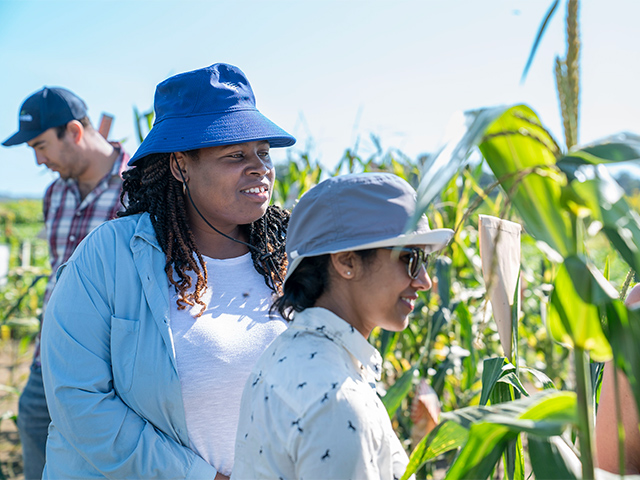
Jaspreet Sandhu, PhD, postdoctoral associate in the Danforth Center Eveland Lab, shows a Maize-10-Maze specimen to Kiona Elliott, PhD, a plant molecular biologist at Bayer. Jaspreet has been the lead on bringing the Maize-10-Maze project to life.
Ten rows total represent all ten chromosomes of corn, and each row features an array of visibly different plants: corn with bronze-colored stalks, corn with knotty leaves, even corn that grows along the ground like a cucumber vine (appropriately known as “lazy corn”). These features—the way that a plant appears or behaves—are known as its phenotype. A plant’s phenotype is determined in large part by its genetic makeup, or genotype. Visiting the Maize-10-Maze is a great way to better visualize the genotype-phenotype relationship in person.
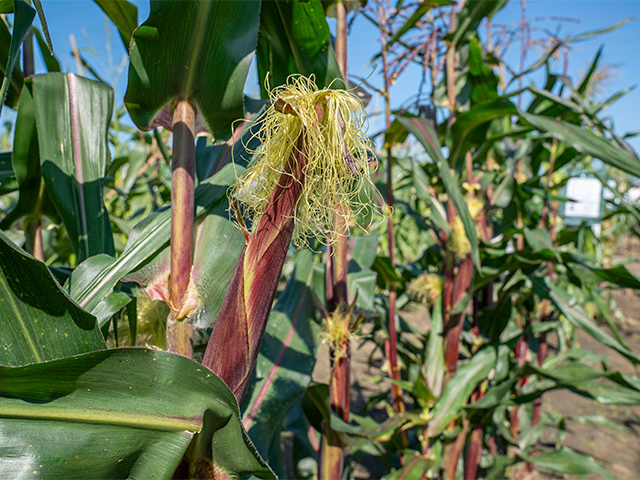
A corn mutant known as bronze1 in the Maize-10-Maize. The unusual, deep red color seen here is the result of a mutation.
“Walking through this field is like walking through the maize genome,” says Postdoctoral Associate Jaspreet Sandhu, who is the lead on the project. “It is a great educational tool.”
From Wild Grass to Golden Harvest: The Domestication of Maize
At the back of the Maize-10-Maze, behind the 10 rows of corn mutants, is a row of the plant that started it all: teosinte, the wild progenitor of maize. Aiming to improve its food quality, indigenous farmers in what is now Mexico transformed this grassy, sprawling, wild relative into the large-eared, single-stalked, and non-branchy plant we recognize today as corn. This process, called domestication, occurred about 9,000 years ago. It required many generations of selective breeding to transform the small, encased grains of wild teosinte grass into the rich source of food that is modern corn.
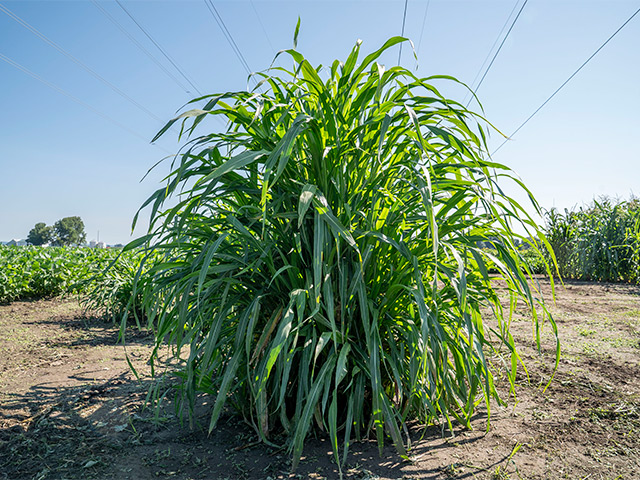
Teosinte, the wild progenitor of maize, is grown in the back of the Maize-10-Maze. About 9,000 years ago, indigenous farmers in what is now Mexico created maize by domesticating teosinte over generations of selective breeding.
There are key differences between teosinte and maize. Maize plants typically have a single shoot that generally produces a large ear(s) and tassel. In contrast, teosinte plants have many long, lateral branches called tillers, each of which produces multiple small ears. Maize ears have a much higher number of kernels (grains) than teosinte. Unlike maize, teosinte grains are enclosed in hard fruit cases. Teosinte ears shatter at maturity to scatter the kernels, while maize ears are non-shattering, allowing the ears to be harvested and used for everything from food to fuel.
A Vibrant Mix of Maize Mutants
One of the mutants featured in the Maize-10-Maze is extremely important to the history of maize domestication. Known as teosinte branched1, this mutation helped scientists understand the specific factors that control whether the plant’s phenotype is expressed as a many-branched, grassy structure versus the single-stalk structure that we are now familiar with in the corn plant. This knowledge played a pivotal role in human understanding of genetics, even beyond maize itself.
“If you’ve worked in maize genetics, you will fall in love with this field,” Jaspreet says. If you haven’t seen maize mutants before but are familiar with Midwest corn fields, this provides a unique opportunity to learn about the diversity of maize plants and the science, especially genetics, behind the development of hybrids or improved crop cultivars.”
Pictured above: are just a few of the dazzling variety of mutants featured in the Maize-10-Maze.
“Some of the mutants have rolled leaves, colored patches on the leaves, or yellow-green leaves,” she explains. “Looking at these mutants prompts you to ask questions like: Why are these mutants showing these phenotypes, and are these phenotypes useful for crop improvement? This can help non-plant scientists begin to understand and connect with plant science.”
Cracking the Code of Corn: Plant Science and the Future
The study of mutant phenotypes like those in the Maize-10-Maze has provided the knowledge for some of the genetic improvements we see in modern maize today. Many of the phenotypes on display in the Maize-10-Maze are extreme and do not necessarily benefit agriculture, but they do provide information on how the underlying gene affects the plant. This allows plant scientists to consider which genes might make crop improvements possible.
One example of this potential is the liguleless1 (lg1) mutant, which puts out leaves that are completely upright. A side effect of this upright leaf angle is that it allows for increased sunlight capture in the lower canopy of the plant.
“If we understand how to precisely manipulate this gene, we can develop plant ideotypes that have optimal angles at each leaf,” Jaspreet explains.
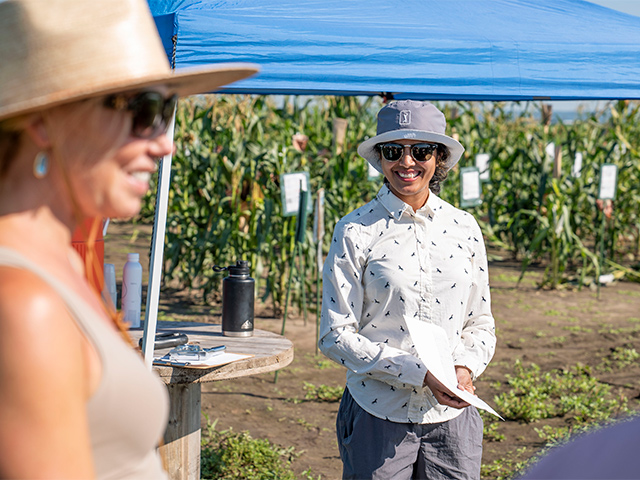
Jaspreet and Principal Investigator Andrea Eveland, PhD, prepare to give a tour of the Maize-10-Maze.
On the other hand, the mutants can help scientists understand what causes undesirable traits as well. Some of the mutants show pleiotropic phenotypes, meaning that a single gene is affecting multiple traits of the plant. This occurrence, known as pleiotropy, is typically detrimental in agriculture. Understanding how several traits are affected by a single gene in these mutants can help scientists uncouple these effects. The Eveland lab has funding from a National Science Foundation (NSF) project to study this phenomenon.
Welcoming Visitors to the Maize-10-Maze
The Maize-10-Maze was started as an NSF-funded education and outreach activity at Florida State University by Professor Hank Bass, PhD. It has now appeared at our Field Research Site for two seasons since the Eveland Lab collaborated with him to bring it to our region in 2023, and they plan to continue planting it for the foreseeable future.
Already, the Maize-10-Maze has seen quite a few visitors, including tours for attendees of the National Association of Plant Breeders Conference, scientists from Bayer, and students at the Jackie Joyner-Kersee Food, Agriculture, and Nutrition (JJK FAN) Innovation Center.
The team’s long-term vision is to make the experience more accessible to the public. Going forward, they hope to collaborate with community science education programs to offer field trips for young scientists or tours for larger groups. The Maize-10-Maize is planted in April each year and looks its best from late June to early August.
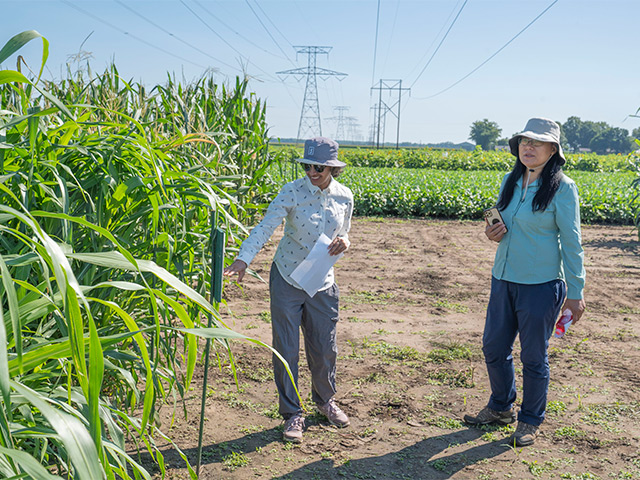
Jaspreet highlights the differences between teosinte and maize.
Bringing the project to life has been a labor of love, requiring dedication and creative problem-solving. Propagating the mutant seed each year poses a challenge, and the team also encountered difficulties with high winds and rain destroying the educational signage in the field. This year, they redesigned the signs to withstand the elements and hand-built them from scrap wood on the field site.
“Making all of this happen here has been a bit of a learning curve,” Jaspreet says, “but we believe these educational plots present a valuable opportunity to connect the public with plant science.”
The Maize-10-Maze presents a truly unique experience for all audiences to understand the basics of crop genetics, a key to the future of our food security, our health, and our planet.